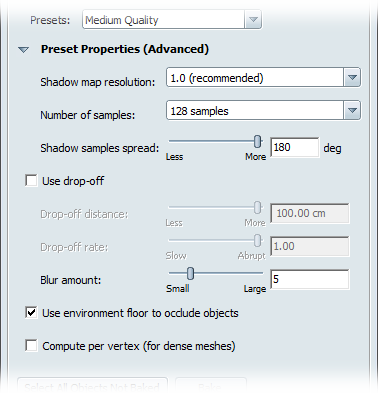Why adjust ambient shadow settings?
Standard ambient shadow calculations may make objects too dark or muddy in certain situations. You may want to:
Advanced ambient shadow controls are only available for baked ambient shadows.
To see advance ambient shadows controls:
 ) beside the appropriate advanced control:
) beside the appropriate advanced control: 
Use these controls to edit shadow presets. To add presets to this list, edit the file at C:\Program Files\Autodesk\Showcase\support\AmbientShadowsPresets\Presets.txt. Copy and paste the text for an existing preset, and then edit it to fit your needs.
Shadow map resolution determines the resolution of the ambient shadow map computed for each object. For performance reasons, the highest resolution is assigned to objects as large as the whole model. The resolution of smaller objects is reduced proportionally with their dimension. A higher resolution (with a large number of samples) could result in sharper detail, but will take longer to calculate.
A resolution value of 1.0 is recommended. A value less than 1.0 will provide a faster calculation time, but poorer results. Values higher than 1.0 will give sharper detail, but will increase calculation time.
This value is related to the texture resolution used in materials, and influences the size of material textures. For example, a shadow map resolution or 2.0 will result in material textures of roughly twice the area of those with a shadow map resolution of 1.0.

When calculating ambient shadows, the software shoots out a hemisphere of rays (samples) from a grid of sample points on the surface, and calculates how many of these rays hit other geometry. The larger the proportion of rays that hit other geometry for any particular point, the darker that point will appear.
A small number of samples means a fast calculation. A large number of samples means a slower calculation time but could result in more realistic ambient shadows.

Select this to consider the distance of surrounding objects as one criterion when calculating ambient shadows. Drop-off is useful to lighten up surfaces in corners or recesses that are surrounded by other surfaces.
(When this setting is not checked, the same level of ambient shadowing is calculated for surrounding objects, regardless of their distance away.)
This check box must be selected to use the following two controls.
Turn this setting off to illuminate the bottom of a model; for example, to show the effect of it floating in space or being underlit.
Computing ambient shadows on vertices will usually produce good results if the object is finely and uniformly tessellated. This will often not be the case, usually because of the adaptive nature of most tessellators. For example, a large, flat rectangle may only be tessellated into two triangles, and four vertices. Using vertex-based ambient shadow computation would then only have four data points to produce, and the results might not be ideal.
If you leave this setting deselected (the default), ambient shadows are computed with textures. This produces better results in most cases, but it assumes, without verification, that the object vertex parameterization contains no overlapping regions. For example, for a closed object, the parameterization would need to be cut, unfolded and flattened, so that no two triangles (in the parameter drawing) overlap. If the object parameterization does not satisfy this requirement, the texture-based ambient shadow computation may produce unsatisfying results. For example, a cube with a sphere above the top space may end up with a shadow on all six faces.